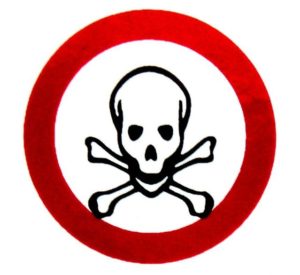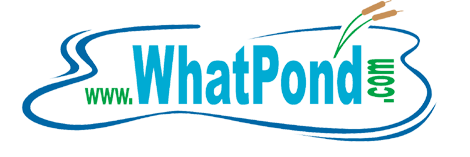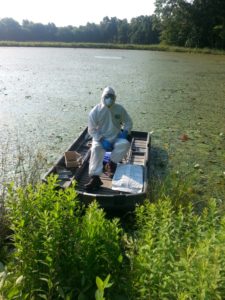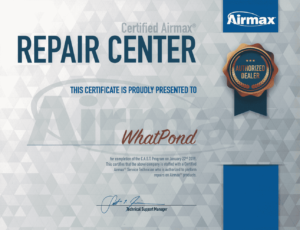 As the title eludes to more a plural word, more than one, more on that in a little bit Then again why would we use a pesticide or herbicide in our ponds? Same as we do for the weeds around the house, unwanted plants growing where we don’t want them. Every year or possibly three times a year we go around the house, fence rows, rock gardens and walls where it is hard to pull weed or we don’t want to. These areas can also be areas we don’t want anything growing except for the plants we want or no plants at all to show off the landscaped areas.
As the title eludes to more a plural word, more than one, more on that in a little bit Then again why would we use a pesticide or herbicide in our ponds? Same as we do for the weeds around the house, unwanted plants growing where we don’t want them. Every year or possibly three times a year we go around the house, fence rows, rock gardens and walls where it is hard to pull weed or we don’t want to. These areas can also be areas we don’t want anything growing except for the plants we want or no plants at all to show off the landscaped areas.
What about using herbicides in our ponds and lakes? Yes they are used all the time for management purposes, controlling open waterways like canals and keeping intake and water exit areas free of plants that could slow or clog the intended use of the water.
For the rest of the article I’m going to use the word chemical in place of herbicide and pesticides. Mainly because we are looking at a chemical reaction by adding the right type of chemical to the water in order to control the growth of a plant. Same thing as going to the doctor and being prescribed pain medication, blood pressure and cholesterol pills and many more but these pills are a chemical that Is affecting one or more parts of our body for a wanted outcome.
I’ve always been a little leery or cautious about using the chemicals in the pond. Even though I’ve gone through all the research, training and licensing It is still being sure you choose the correct chemical for the plant/weed you want to control. Along with the pre prep of notifying residents around the pond and acquiring all the proper permits. Then once all the “T’s” are crossed and the “I’s” are dotted it’s time to suit up in the proper PPE and begin the treating of the pond.
By law you should use the least amount and least potent chemical to achieve the desired results. Also you need to use the product as the direction imply and what the label says it is for. Meaning you can’t use something called Cattail killer to treat Duck Weed. Getting caught can be a heavy fine. At least in Pa. Other states may have the same laws or no laws so check with your state to be sure you can use a chemical for your pond and if you need to apply for a permit(s) or not.
What chemical to use for your situation? There a hundreds of brands of chemicals out there and they have different plant and weeds they will treat. The labels will tell you the amount of chemical to use, how to treat the pond and the needed PPE, (personal protective equipment) to keep you safe from harm while using that particular product. Since there are different types of plants, floating, floating rooted, submerged, emergent and terrestrial there is a start of some of the different chemicals that could be used on thee different type plants. Plant specific chemicals come into play due to some of the plants/weeds have become immune to the chemical treatments, same as some of the viruses and insects that have become immune as well.
Mentioned earlier about using the less potent and least amount to achieve the desired results is a maintenance application, the plants/weeds are affected and die off. Generally a contact type herbicide is used for this type of treatment. The chemical must contact the target in order to be effective and most always a spreader/sticker/adjuvient is also mixed in the chemical solution to help break down the plant surface to allow the chemical to get in or helps the chemical to stick to the plant to be effective and sometimes to help spread across the water’s surface. RE-application will be required each year or sometime the same year even monthly applications to control the weed growth. There are more potent chemicals but may need to be licensed to purchase, have a permit number or have an applicators permit or all of the above to make the actual purchase to use those chemicals. These chemicals are known as systemic meaning the chemical gets on the plant leaves or stem and travels to the roots to kill a the roots. Similar to Round Up or some of the cattail brand chemicals.
9 times out of 10 fish kills happen not because of the chemical treatment but rather the application of the chemical being done to the entire pond. Yes, using the improper chemical or wrong mixture can be a factor which could kill fish and other wildlife in the pond. Only a ¼ or 1/3 of the pond should be treated at a time due to the plants that are dyeing is using oxygen from the water column robbing the oxygen from the fish to breathe. Ideally if you are able it would be beneficial to pull these plants out of the pond once they are dead. This will be helpful in removing the excess material which will become muck and sludge build up on the bottom of the pond and added nutrients for more weed or algae growth.
Once the weeds/plants have been treated it is also a good idea to start looking at proactive treatments using a beneficial pond bacteria to consume the organic debris left behind from the dying plants. This will help to break down the plants and consume the muck that has built up over the years, even remove the foul odors the muck gives off.
Bottom Diffused Aeration can help with the chemical treatments and have even more benefits for the ponds health. For the fish, they will breathe easier with the added oxygen and have more room in the pond to use since we’ll have oxygen to the bottom of the pond. Now that we have oxygen to the bottom of the pond the beneficial pond bacteria can work to the depths of the pond consuming the muck and sludge. Bottom aeration is the biggest bang for the buck since we are using air to move water instead of a fountain which requires more horse power to move less water and only creates surface aeration, but nice to look and listen to.
Last thoughts are from a conference I attended and the main speaker had talked about a weed species that has taken in the south and the years of research and management practices they used to help control and manage the nuisance weed. Finding out that the tuber banks can be dormant for years the management plan had to be setup or committed to a 7 year treatment plan to be sure the plant, roots, seeds and tubers have been affected by the chemical. Even the grass carp had been used in other lakes where chemicals were not permitted, mainly to manage the biomass of the plant to keep them below the surface. I guess the amazing part is the stocking where up close to 10,000 fish, not a cheap date but the chemicals are not cheap either.
Lastly, I have applied chemicals to a couple ponds, going through the proper permits and plenty of research, planning and discussion with my chemical supplier before we even thought about going with the use of chemicals. There are times when chemicals are a good method to control unwanted pond weeds., but if you can manage them by hand or other mechanical ways it would be better for the environment.
Plan, research and be safe. If you need help let us know by using the contact form at the top of the website.
What is missing in the picture for PPE? Leave a comment below



Comments on this entry are closed.
Life jacket